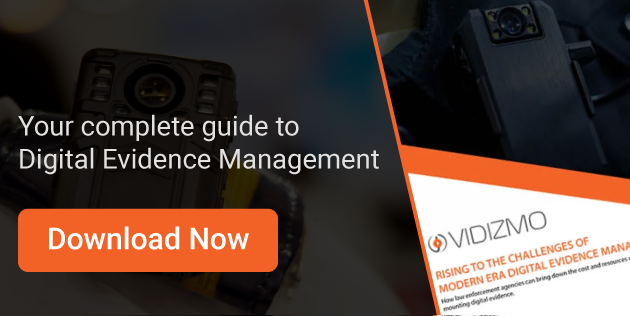Law enforcement agencies handle vast amounts of digital evidence, making secure storage, management, and tracking essential. Evidence tracking software streamlines investigations, maintains chain of custody compliance, and ensures digital evidence remains admissible in court. This blog explores its key benefits and how agencies can implement it effectively.
Why Law Enforcement Agencies Need a Digital Evidence Tracking Software
by Nohad Ahsan, Last updated: March 26, 2025, Code:
![]()
Imagine a police department investigating a high-profile case. A critical piece of digital evidence—a surveillance video capturing a suspect in action—exists, but officers spend hours searching through fragmented storage systems to locate it. By the time they retrieve it, the chain of custody is compromised, and the defense challenges its authenticity in court. Unfortunately, this is the reality for many law enforcement agencies that lack a centralized evidence-tracking system.
Digital evidence has become a cornerstone of modern investigations. According to a Bureau of Justice Statistics report, over 90% of law enforcement agencies now rely on body-worn cameras, surveillance footage, and digital forensic data in criminal cases. However, without efficient evidence tracking software, officers waste valuable time, cases face delays, and the integrity of evidence can be compromised.
With the rising volume of digital evidence—ranging from body cam recordings and dashcam footage to mobile phone videos and forensic reports—law enforcement agencies need a secure, automated solution to store, manage, and track evidence efficiently.
This blog explores how evidence-tracking software streamlines investigations, ensures chain of custody compliance and enhances legal admissibility in court.
What Does an Evidence Tracking Software Do?
Law enforcement agencies handle vast amounts of digital evidence, from body-worn camera footage and surveillance recordings to forensic reports and mobile phone extractions. Without a structured system, managing and securing these critical pieces of evidence becomes time-consuming and error-prone.
A robust evidence tracking software eliminates these inefficiencies by automating processes, ensuring security, and maintaining chain of custody integrity.
1. Automating Evidence Ingestion for Faster Case Processing
Manual evidence collection and entry introduce delays and increase the risk of misplaced or mishandled files. Evidence tracking software automates the ingestion process, allowing seamless transfer of digital evidence from multiple sources, including:
- Body-worn and dashcam footage captured during field operations.
- Surveillance systems and security cameras monitoring public and private locations.
- Forensic tools extracting mobile, computer, and cloud-based evidence.
- Third-party agencies or witness submissions for external contributions to cases.
By automating this process, agencies can eliminate redundancies, accelerate investigations, and ensure all evidence is securely stored in a centralized location.
2. Ensuring Chain of Custody Compliance with Tamper Detection and Audit Logs
In legal proceedings, the integrity of digital evidence is non-negotiable. If the chain of custody is broken, defense attorneys can challenge the authenticity of evidence, potentially leading to case dismissal.
Evidence tracking software ensures strict chain of custody compliance by:
- Recording every action taken on an evidence file (who accessed it, when, and for what purpose).
- Detecting tampering attempts with built-in integrity verification tools.
- Generating automated audit logs that create a complete history of the evidence lifecycle.
With these safeguards in place, agencies can demonstrate the authenticity and integrity of digital evidence in court without concerns over manipulation or loss.
3. Seamless Integration with Law Enforcement Systems for Efficiency
Investigators often juggle multiple platforms, from Records Management Systems (RMS) to Computer-Aided Dispatch (CAD) software. Without system interoperability, officers must manually transfer data between systems—a process prone to errors and inefficiencies.
An advanced evidence tracking software integrates with:
- RMS platforms, enabling officers to link evidence directly to case files.
- CAD systems, ensuring real-time access to incident reports and case updates.
- Forensic analysis tools, allowing seamless ingestion of extracted digital evidence.
- Judicial and prosecution platforms, simplifying evidence sharing with attorneys and courts.
By eliminating siloed operations, law enforcement agencies can streamline case management and improve operational efficiency.
4. Leveraging AI for Evidence Processing: Transcription, Redaction, and Facial Recognition
Manually analyzing video evidence is a time-intensive process. Investigators often spend hours reviewing footage, transcribing audio, or redacting sensitive information. AI-powered automation accelerates these tasks, making investigations more efficient.
Key AI-driven capabilities include:
- Automatic transcription of video/audio evidence, converting spoken words into searchable text.
- Redaction tools for blurring faces, license plates, and confidential details.
- Facial and object recognition is used to quickly identify individuals or specific elements in video footage.
- Speech and keyword analysis, helping officers detect key phrases in recorded conversations.
With AI-powered automation, law enforcement agencies reduce manual workloads, allowing officers to focus on solving cases faster.
5. Providing Secure Storage and Access Control to Prevent Unauthorized Use
Digital evidence contains highly sensitive information, including personal identities, confidential case details, and forensic findings. Unauthorized access or leaks can jeopardize investigations and violate privacy laws.
A top evidence management software provides:
- Role-Based Access Control (RBAC) to restrict user permissions based on rank or assignment.
- End-to-end encryption to protect files from cyber threats.
- Multi-factor authentication (MFA) for additional security.
- Secure external sharing options for authorized legal entities.
By implementing these security measures, law enforcement agencies can ensure compliance with regulatory frameworks like CJIS, GDPR, and HIPAA, preventing unauthorized access while maintaining operational transparency.
Takeaways
By adopting evidence-tracking software, law enforcement agencies can transform their evidence management workflows, improving operational efficiency and ensuring evidence remains admissible in court. Through automation, AI integration, and enhanced security, digital investigations become faster, more reliable, and legally defensible.
Challenges in Law Enforcement Evidence Management
Managing digital evidence is not just about storage; it involves ensuring accessibility, security, compliance, and integrity. Law enforcement agencies must handle vast amounts of digital evidence, including body-worn camera footage, surveillance recordings, forensic extractions, and mobile phone data. Without a centralized and secure system, agencies face several challenges that can compromise investigations and legal proceedings.
1. High Costs of Outsourcing Transcription, Redaction, and Other Processes
Many law enforcement agencies lack in-house resources to transcribe audio/video recordings or redact sensitive information efficiently. As a result, they outsource these processes, which:
- Increases operational costs, especially for agencies handling large volumes of digital evidence.
- Causes delays in investigations and legal proceedings due to third-party processing times.
- Raises security risks, as evidence is shared with external vendors, increasing potential exposure to unauthorized access.
2. Limited Internal Expertise and Resources to Handle Growing Evidence Volumes
With the rapid expansion of digital and forensic evidence, law enforcement agencies struggle with:
- Insufficient technical expertise to manage complex digital evidence formats.
- Lack of IT infrastructure to support large-scale storage and retrieval needs.
- Limited staff training on digital evidence handling, leading to mismanagement and chain of custody risks.
3. Compliance with Legal Frameworks Requiring Secure Storage and Accessibility
Digital evidence must meet strict legal and regulatory requirements to be admissible in court. Agencies must comply with:
- CJIS (Criminal Justice Information Services) for data security and access control.
- GDPR (General Data Protection Regulation) for handling evidence related to EU citizens.
- HIPAA (Health Insurance Portability and Accountability Act) when dealing with medical-related evidence.
Failure to meet compliance standards can lead to:
- Legal challenges or case dismissals due to improper handling of evidence.
- Unauthorized access and data breaches compromise sensitive investigations.
- Fines and penalties for non-compliance with government regulations.
4. Fragmented Systems Hindering Case Management and Analysis
Many law enforcement agencies operate with disconnected systems, including:
- Standalone file storage solutions that lack integration with case management systems.
- Manual documentation and spreadsheets, leading to errors and inefficiencies.
- Incompatible legacy software that does not support modern digital evidence formats.
These inefficiencies cause:
- Delays in retrieving evidence for court proceedings.
- Inconsistencies in records, making it difficult to track chain of custody.
- Redundant data entry, increasing workload and human error risks.
Why Evidence Tracking Software is Indispensable
With digital evidence growing exponentially, law enforcement agencies can no longer rely on outdated storage methods and manual processes. A robust evidence tracking system addresses these challenges by:
- Reducing reliance on third-party services through AI-powered automation.
- Ensuring chain of custody and compliance with strict regulatory requirements.
- Integrating with existing case management tools, eliminating inefficiencies.
By adopting a modern evidence management solution, agencies can streamline operations, enhance security, and improve case outcomes, ensuring that digital evidence remains legally admissible and securely stored.
How Does VIDIZMO Digital Evidence Management System Address This Dilemma?
VIDIZMO Digital Evidence Management System (DEMS), built on Gartner-recognized Enterprise Video Content Management (EVCM) System, is a digital evidence tracking software that offers a comprehensive solution to all the aforementioned challenges faced by law enforcement agencies while managing digital evidence.
Unified Media Portal
VIDIZMO Digital Evidence Management System provides a centralized repository to ingest evidence in variable formats from any source, including the sheriff’s office, police, witnesses, and other external agencies.
Deployment Options
All content is securely stored on-premises or on any commercial or government cloud. Cloud deployment allows law enforcement agencies to use cloud-based artificial intelligence services, including automatic transcription and translation, facial, speech, and object recognition, redaction, and much more, which helps investigators with analysis and makes for swift justice.
Alternatively, on-premises deployment allows customers to leverage legacy systems and existing IT infrastructure, as the application is hosted behind a corporate firewall over the customer’s private LAN, WAN, and CDN.
Security and Access
Security is undeniably the most crucial aspect of digital evidence management. With VIDIZMO DEMS, we provide best-in-class security through enterprise single sign-on.
In addition, VIDIZMO DEMS provides complete control over all user actions and content access rights through its built-in Role-Based Access Control (RBAC), where users can be mapped to various roles, either manually or via an automated active directory synchronization process.
Media can also be shared with external users using third-party logins, requiring authentication via Google, Microsoft, or VIDIZMO ID. DEMS also comes with chain of custody, tamper detection and audit logs out-of-the-box that ensures the integrity and admissibility of the digital evidence in the court of law.
Index and Search
Once ingested and stored, all evidence is then catalogued, organized, tagged and linked to other case management tools.
Users can then utilize VIDIZMO’s intelligent indexing and search capabilities to quickly locate or extract any media within seconds, thus speeding up investigations and dramatically shortening data search times.
Transcription and Closed Captioning
VIDIZMO DEMS automatically transcribes all videos while also allowing users to make edits to transcriptions. Machine generated transcription converts spoken words into searchable and indexable text, thereby speeding up evidence processing by avoiding long delays involved in manual transcription.
This allows users to quickly search and jump to a spoken word within the transcribed text. Where required, VIDIZMO also enables closed captioning in videos, to add clarity to video and audio files, as well as increase searchability and accessibility for those with hearing disabilities.
Analytics
VIDIZMO DEMS maintains detailed audit logs to track all user actions, allowing administrators to validate the integrity of the original source. Administrators can also monitor progress using detailed user analytics and reports about content consumption for officer induction, training, and education.
Device and Network Agnostic Playback
Once processed, content can be played across all devices for viewing by authorized users, including mobile phones, laptops, PCs, tablets, etc. Also, using adaptive bitrate streaming, video content can be played in the best suited rendition for the network, which makes for a smooth viewing experience.
Automatic File Deletion
Administrators can set a time frame for content availability and expiration, depending on archiving requirements. Upon the scheduled expiration of the file retention period, the automatic deletion feature automatically deletes archived content.
Video Editing
VIDIZMO provides a wide range of video editing features to make the content suitable for purposes of discovery, dissemination and presentation to prosecutors, defense attorneys, and judges.
How Digital Evidence Impacts Court Cases and Investigations
Digital evidence has transformed the way criminal and civil cases are investigated and prosecuted. With the rise of technology, law enforcement agencies and legal professionals now rely heavily on video recordings, digital documents, and forensic data to build stronger cases and ensure justice is served.
The Role of Digital Evidence in Criminal Cases
In criminal cases, digital evidence can confirm alibis, identify suspects, and prove intent. It includes:
- Body-worn camera footage capturing real-time interactions between officers and suspects.
- Surveillance video from public or private security cameras.
- Cell phone records and GPS data providing location-based evidence.
- Computer forensics revealing deleted files, emails, and search histories.
Real-World Example:
In the George Floyd trial (2021), video footage from bystanders and body-worn cameras played a pivotal role in proving the prosecution’s case, leading to a conviction. Without this digital evidence, it would have been much harder to establish what actually happened during the arrest.
The Role of Digital Evidence in Civil Cases
In civil litigation, digital evidence is used in:
- Corporate fraud cases – Emails, financial records, and system logs can track fraud schemes.
- Personal injury lawsuits – Surveillance footage or dashcam videos help verify accident claims.
- Workplace harassment cases – Digital messages and video recordings serve as proof of misconduct.
Real-World Example:
In Waymo vs. Uber (2018), forensic analysis of emails and cloud storage helped uncover the theft of proprietary self-driving car technology, leading to a $245 million settlement in favor of Waymo.
As digital evidence becomes more central to legal proceedings, secure evidence tracking software is crucial to maintaining its integrity, authenticity, and legal admissibility.
Common Challenges in Implementing an Evidence Management System
Despite the clear benefits, many law enforcement agencies face hurdles when transitioning to a digital evidence tracking system.
1. Resistance to Technology Adoption
- Law enforcement agencies often rely on traditional paper-based or manual evidence tracking, making a shift to digital solutions challenging.
- Officers and administrators may be reluctant to adopt new systems due to unfamiliarity or lack of IT expertise.
Solution:
A user-friendly evidence tracking software with intuitive interfaces and training programs can make adoption smoother and increase efficiency.
2. Budget Constraints
- Digital evidence management solutions require investment in cloud storage, security measures, and AI-driven tools.
- Agencies with limited funding may struggle to justify the expense, despite the long-term benefits of automation.
Solution:
Cloud-based Software-as-a-Service (SaaS) models allow agencies to pay for only what they need, reducing upfront costs.
3. Training Challenges
- Law enforcement personnel need training on how to handle, tag, and search for digital evidence within new systems.
- Without proper training, mismanagement of digital files can occur, leading to chain of custody issues.
Solution:
Modern evidence tracking software provides built-in training modules, step-by-step workflows, and automated guidance, reducing the learning curve for new users.
4. Integration with Legacy Systems
- Many agencies already use Records Management Systems (RMS) and Computer-Aided Dispatch (CAD), making integration with new digital evidence management software a challenge.
- Without seamless integration, officers must manually input data, increasing workload and errors.
Solution:
A flexible evidence tracking software should support API integrations with existing law enforcement tools, allowing for automated ingestion and streamlined operations.
Key Takeaways from the Blog
Digital Evidence is Essential for Law Enforcement
- Over 90% of law enforcement agencies rely on body-worn cameras, surveillance footage, and forensic data in investigations.
- Without proper evidence tracking, agencies risk delays, inefficiencies, and compromised chain of custody.
Challenges in Digital Evidence Management
- High costs of outsourcing transcription and redaction.
- Lack of internal expertise and IT infrastructure to manage growing evidence volumes.
- Regulatory compliance issues with CJIS, GDPR, and HIPAA.
- Fragmented systems leading to inefficient case management and potential evidence mishandling.
How Evidence Tracking Software Solves These Challenges
- Automates evidence ingestion from multiple sources (body cams, forensics, witness uploads).
- Maintains a secure chain of custody with tamper-proof audit logs.
- Integrates with existing law enforcement systems (RMS, CAD, forensic tools).
- Uses AI-powered automation for transcription, redaction, and facial recognition.
- Provides advanced security controls (Role-Based Access Control, encryption, multi-factor authentication).
The Role of Digital Evidence in Court Cases
- Critical in criminal cases (e.g., surveillance footage proving a suspect’s actions).
- Valuable in civil litigation (e.g., fraud investigations, workplace disputes).
- Ensures evidence remains admissible by meeting legal compliance and chain of custody requirements.
VIDIZMO Digital Evidence Management System (DEMS) as a Solution
-
- Offers a centralized, secure platform for storing and managing digital evidence.
- Enables automated compliance with legal regulations through secure access controls and audit logs.
- Enhances efficiency with AI-driven search, tagging, and transcription features.
- Provides scalable cloud and on-premises deployment options based on agency needs.
Enhancing Law Enforcement Efficiency with Evidence Tracking Software
Managing digital evidence is a complex yet critical aspect of modern law enforcement. Without evidence tracking software, agencies risk delays, security breaches, and compliance failures that can undermine investigations and legal proceedings.
A robust solution ensures chain of custody integrity, seamless case management, and AI-driven automation, ultimately making digital evidence more accessible and legally defensible.
By implementing best evidence management software, law enforcement agencies can streamline workflows, reduce manual workloads, and enhance operational efficiency. The right system not only secures digital records but also integrates with existing law enforcement tools, ensuring a centralized, compliant, and scalable approach to evidence management.
If you’d like to learn more about how VIDIZMO Digital Evidence Management System can help your organization, sign up for a free trial today.
People Also Ask
What is evidence tracking software, and why is it important for law enforcement?
Evidence tracking software is a digital solution that helps law enforcement agencies store, manage, and track digital evidence while maintaining chain of custody integrity. It ensures that evidence remains secure, easily accessible, and legally admissible in court, reducing risks associated with data loss, unauthorized access, and manual handling errors.
How does evidence tracking software help maintain the chain of custody?
A robust evidence tracking system logs every interaction with a digital file, including who accessed it, when, and what changes were made. It also includes tamper detection, audit logs, and access controls, ensuring that digital evidence remains authentic and legally defensible in court.
What types of digital evidence can be managed with evidence tracking software?
Law enforcement agencies can manage various types of digital evidence, including body-worn camera and dashcam footage, surveillance and CCTV recordings, mobile phone extractions and forensic reports, audio recordings, interviews, transcriptions, electronic documents, images, and emails.
What are the key features of the best evidence management software?
The best evidence management software includes automated ingestion of digital evidence from multiple sources, chain of custody tracking with tamper-proof audit logs, AI-powered automation for transcription, redaction, and facial recognition, integration with RMS, CAD, and forensic analysis tools, and advanced security controls such as role-based access, encryption, and multi-factor authentication.
How does AI improve evidence management for law enforcement agencies?
AI-powered evidence tracking software automates key processes, such as automatic transcription of video and audio files for faster analysis, AI-based redaction to blur sensitive information in videos and documents, facial and object recognition to identify suspects and key evidence, and advanced search capabilities that allow officers to find specific moments in video evidence quickly.
How does evidence tracking software help with legal compliance?
Digital evidence must comply with CJIS, GDPR, HIPAA, and other regulations. Evidence tracking software ensures secure storage, controlled access, and audit logging, helping agencies meet legal requirements and prevent unauthorized data exposure.
Can evidence tracking software integrate with existing law enforcement systems?
Modern evidence management software integrates with records management systems for seamless case linking, computer-aided dispatch for real-time incident reporting, forensic tools for digital analysis and data extraction, and judicial and prosecution platforms for efficient case processing.
How can law enforcement agencies implement evidence tracking software?
Agencies can implement evidence tracking software by evaluating their current evidence management challenges, selecting a scalable and compliant solution, integrating it with existing case management tools, training officers and staff on digital evidence handling, and ensuring ongoing security updates and compliance checks.
What deployment options are available for evidence tracking software?
Agencies can choose between cloud-based deployment, which offers scalability, AI automation, and remote access, or on-premises deployment, which provides full control over data with enhanced security.
How can law enforcement agencies get started with VIDIZMO Digital Evidence Management System?
Law enforcement agencies can sign up for a free trial to explore VIDIZMO DEMS and see how it can improve evidence tracking, enhance security, and streamline case management.
Jump to
You May Also Like
These Related Stories

Why Cloud is the Smart Choice for Law Enforcement

Cost-Effective Cloud-Based Evidence Management for Law Enforcement




No Comments Yet
Let us know what you think